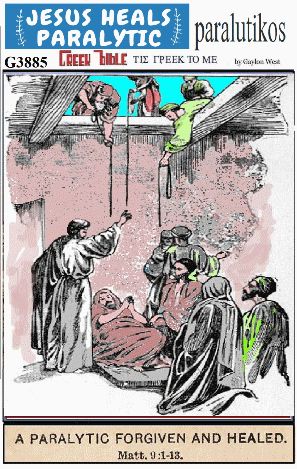DEMON POSSESSION #4
Paralytics and Spirits


“And his fame went out into the whole of Syria, and they brought to him all that were ill, suffering under various diseases and pains, and those possessed by demons, and lunatics, and paralytics; and he healed them.” (Matthew 4:24, Darby).
When we consider the healing miracles of Jesus, it is helpful that one of the sicknesses healed is identified by an Anglicized word. I have in mind the word "palsy" (KJV) in Matthew 4:24. When we read the word palsy in the English (KJV) translation, we immediately recognize the similarity to our word paralysis. These sick with palsy were individuals that were in someway paralyzed (see Notes below). An awareness of English words identical to the origional Greek word helps us, I think, to travel mentally to the century that Jesus walked on the earth. In some cases we can better understand the message. In this case we can appreciate the illnesses.
ALL THAT WERE ILL (Matt. 4:24). “All” is PASG3956, in the original, (from which we get the neuter word-forming for English, "PAN")i “all (manner of; as many as” (Strong's definition) were ill were brought. "All" is the same word used in the prophecy in Joel 2 of the Holy Spirit being poured out on “all flesh” (Acts 2:17). That "all" was fulfilled when represented by the nations, Jew and eventually Gentile (Acts 11:15). There were then in our text representative kinds of sick people brought to Jesus.
"ILL" OR "SICK" ii used here means “badly or ill (morally or physically -here obviously the latter--gw): [i.e.] diseased, evil, miserable, or sick" (Strong's). The Greek authority, A.T. Robertson's Word Pictures, comments, "literally 'those who had it bad' ...” They were “suffering”; i.e., “taken with” or “held” as Jesus was forced by men in Luke 22:63. Those ill coming to Jesus were really bad off physically in the following category.
PAINS AND TORMENTS. So many multiple pains and torments are common to mankind's illnesses, and yet we are assured that Jesus was able to heal all those so strickened that came to him in "Syria" (Palestine area). They were of "various" (KJV: divers) kinds. There were those suffering of various pains (“maladies”iii) along with those with various torments (“the worst of torturesiv). The Scriptures says "He healed them."
If we understand the grammar correctly, this passage conveys that there were in addition to these various painful "maladies" and "torments" three additional classes: (1) obsessed demoniacs (Matthew 8:16v), (2) "lunatics", plus (3) those "paralyzed." There were at least four classes then that Jesus was providing therapy; i.e., "healing service." vi
MATTHEW 4, when mentioning maladies and pains, adds demoniacs, lunatics and paralytics. The original Greek passage separates them with the coordinating conjunction "and" (in Greek, kai). The word kaiG2532 was a copulative particle that served in Greek very much like our English word "and." However, if kai indicated something else like e.g., "a cumulative force", in a context, the translators used appropriate English words such as "even", "so then", "too"vii; otherwise, it was translated as “and”, which is strictly a coordinating conjunction.
ENGLISH WORD “AND.” What is meant by the definitive use of “and”? Our English word “and” is by definition “a coordinating conjunction”, like “or” and “but”, that “connects words, phrases, and clauses that are of EQUAL importance in the sentence.viii The paralytics that Jesus healed are therefore in addition to those possessed by demons (i.e., not the same). That doesn't mean that some demoniacs were not cursed with paralysis but in this case there was simply a separate class of ill persons who were paralytics that came to Jesus and were healed.ix
WHAT ABOUT THE “SPIRIT” OF INFIRMITY (Luke 13:11)? Some will point to the woman with the spirit of infirmity and ask, “Was she not possessed?” Jesus was teaching in one of the synagogues on the Sabbath and there was a woman that was bowed together (stooped), and could not lift up, and this had been true for 18 years. The text says it was due to a spirit of infirmity (shackles of feebleness). Some students consider that this meant that it was another case of demon possession and that the possession was palsy. x
CHARACTERISTICS. This is obviously an interesting example of the illness. But unlike His normal healing of demon possessions, Jesus did not command a spirit to leave the woman. ? The healing was simply Jesus calling to her and saying, “Woman, thou art loosed from thine infirmity” followed by His customary means of healing natural diseases, He used His tactile method of putting His hands on her like a common illness.
Immediately she was made straight. In this case, can we conclude that sometimes the possession of a demon involved palsy? Maybe, but this case was different. In His verbal explanation Jesus attributes the source of the infirmity to Satan (Luke 13:10-17) the prince of demons (verse 16; 11:15, 18) but not demons. There is a disagreement among students. The argument is that the expression “demon-possession” is not specifically listed and Jesus did not cast a spirit “out.” Although this is obvious, it is interesting to me that this word “had” (“a spirit”) is ἔχωG2192 (in Luke 13:11) which is the same word translated “possessed” in both KJV's Acts 8:7 and Acts 16:16. However, the fact we read in Matthew 4 is that some cases were strictly only paralytic. If one has arthritis, although Satan has permission to authorize it (Job 1,2), the victim can not summarily be concluded that the he has a demon. However, it must be conceded that the person's life style may have caused it or it may be a test like that given to Job. But there is no authority for any exorcism.
SUMMARY. We are not to suppose or conclude that a paralytic was ever possessed with a demon then or today. Palsy as such is not a necessary characteristic of demon possession.
Notes for Paralytic.
Strong's Hebrew and Greek Dictionaries
G3885 παραλυτικός paralutikos par-al-oo-tee-kos' Total KJV occurrences: 10
From paraluō G3886; to loosen beside, that is, relax (perfect passive participle paralyzed or enfeebled; as if dissolved, that is, “paralytic”: - that had (sick of) the palsy.
G3886 PARTICIPLE Total KJV Occurrences: 5
palsy, 3 times Luke 5:18, Luke 5:24, Acts 9:33
feeble, 1 Hebrews 12:12
palsies,
1 Acts
8:7
For
unclean spirits, crying with loud voice, came out of many that were
possessed
with
them:
and
many taken with
palsies,
and that were lame, were healed.
NOTICE THE DISTINCTION IN THIS BIBLICAL TEXT.
GaylonWest
BibleStudyLessons.net
